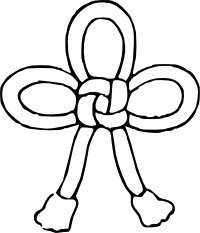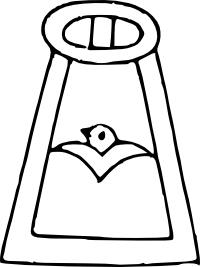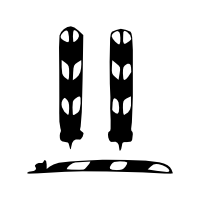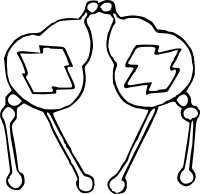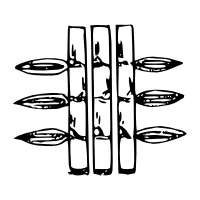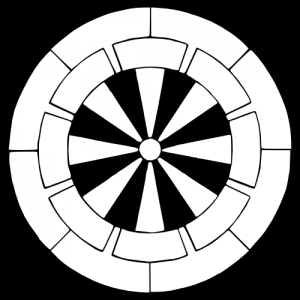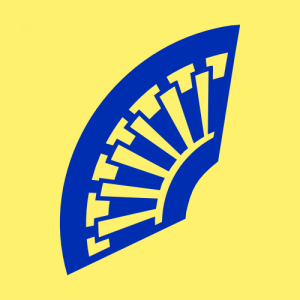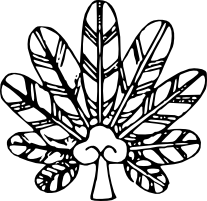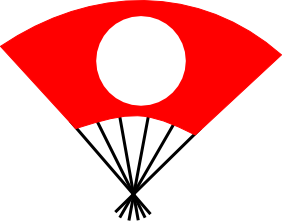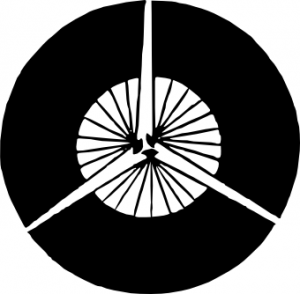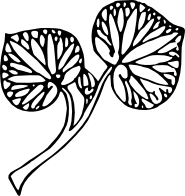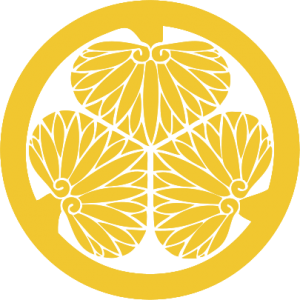Recreational research into Feudal Japan
Posts tagged samurai
Link: Samurai Heraldry: Flags and Standards of Samurai Armies
Dec 27th (a Tomobiki (友引))
It’s still a while before the lunar New Year, but I hope those of you with modern holidays are enjoying them. Perhaps one of these winters I’ll actually girl up to building a Sei Shonagon-style snow mountain. I just wanted to follow up my recent link post on samurai banners: some more banner depictions by the same artist and more background information can be found in a forum thread: Samurai Heraldry: Flags and Standards of Samurai Armies. May the your modern New Year be auspicious to you all.
Mon of the Week: Knot
Nov 28th (a Tomobiki (友引))
Continuing with the provincial samurai mon, we have this simple depiction of a knot.(KJ:7)
This is not just any knot, however. This knot is called “agemaki” (総角) and auspiciously symbolizes the four directions. It is hung above sumo rings, and was used on samurai armor both for decoration and as a structural component.(Samurai Weapons) For these reasons and its graphical simplicity, it makes a lot of sense as a samurai mon. Slightly more stylized depictions continue to be used in mon today,(Kamon Composition Maker) albeit rarely.
Less relevantly, it names a similar-looking historical (but later) hairstyle and type of dance in kabuki. Nowadays, they are used to decorate cars in Japan’s “VIP style”.(Diamond Zeus)
Mon of the Week: Enclosed Goose
Oct 25th (a Tomobiki (友引))
At the other end of the spectrum in terms of realism from the Perching Hawk is this mon below, from the same collection of provincial samurai mon.(KJ:7) The highly stylized bird in the middle is a wild goose, and this depiction of geese is still common through the present day. Geese are associated with good news and gracefulness.(NHK Online) More mysterious is the enclosure around the goose. It bears some similarity to a piece of horse equipment (aori/泥障) that would hang from the saddle and sit between the rider’s legs and the horse’s body; these could be decorated with mon the way the plover image appears here. This explanation isn’t entirely convincing, so there could be other possibilities.
Note: This entry originally inaccurately identified the bird as a plover instead of a wild goose. Plovers were a common motif in Japanese poetry, with connotations of longevity based on their cry “chiyo” (thousands of generations).(Komuso)
In addition, one source identifies this enclosure as tongs.
Element of the Week: Feathers
Sep 27th (a Sembu (先負))
Today we look at a straightforward motif in mon: feathers. Generally described as hawk’s feathers (or, depending on translation, falcon’s feathers), they are graphically simple and have flexibility in number and arrangement. They have a military connotation, both from hawks being hunting birds and from the tradition of fletching arrows with feathers from birds of prey.(Kyudo) Falconry was also a popular and respected sport for both samurai and nobility from the Heian Period (794–1185).(Dower:94)
Here we have a simple 5-feather mon from the Muromachi-period collection of provincial samurai mon.(KJ:7) It shows the more free-form nature of earlier mon by being notably wider than it is tall, which became rarer as mon became more formalized.
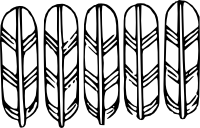 Watch movie online The Lego Batman Movie (2017)
Watch movie online The Lego Batman Movie (2017)
This even earlier mon, used by the Kikuchi family in the 14th century,(SH:14) is interesting for its use of a half feather, an unusual way of creating a distinctive mon. The same family would later use other mon incorporating an even two feathers.(en.wp:Kikuchi_clan)
Mon of the Week: Pine-bark Gourds
Sep 6th (a Butsumetsu (仏滅))
Here we have another mon incorporating the chestnut/diamond motif discussed earlier, this one from the 15th century colection of provincial samurai mon.(KJ:7) This mon uses a variation of the three chestnut design with the bottom diamond small to match the top one. This variant is called the “pine-bark diamonds” (松皮菱/matsukawa hishi),(IEJFC:352.2) for reasons that are unclear. The chestnut designs are on gourds of a type (瓢/hisago, “bottle gourd”) that was hollowed-out, dried, and used to carry water. The gourds are in turn supported by mysterious ball-ended sticks. These may be stylized vines or representations of the cords that would often be tied around the middle of such gourds to carry them. They may also represent sticks used to hit gourds when using them as percussion instruments, often for religious purposes.(EAH:Bottle Gourds)
This version of the three-diamonds motif tessellates well, and was also used as a fabric pattern in the Momoyama period (1568–1603).(JAANUS:Matsukawabishi)
Mon of the Week: Three Bamboo Poles
Sep 6th (a Butsumetsu (仏滅))
Bamboo groves are commonplace in Japan, and bamboo has long been used as a construction material and for uses such as piping (due to its hollowness) and can easily be sharpened into a spear. Here we have a different take on bamboo found in the collection of provincial mon.(KJ:7) Unlike the more popular depiction of bamboo leaves in clumps, as we saw in our recent fan with bamboo, this mon has single leaves protruding sharply at right angles from the trunks. This gives the leaves a harsher, almost spearhead-like appearance. With the minimal information given by the source, any motivation behind this depiction would be pure speculation; suffice it to say that while variations of bamboo have always been popular in Japanese heraldry and design, this particular version did not catch on.
Motif of the Week: Folding Fans
Jun 14th (a Senshō (先勝))
A while back we talked about one type of fan used in mon, but the type of fan everyone associates with Japan is the standard folding fan. This was a very popular motif in mon through the centuries. Its origins as a design motif date to the Heian period (794–1185).(Dower:110)
Here are two folding fans from our collection of 15th century provincial samurai mon.(KJ:7) The one on the left is a cypress fan, which was part of the traditional court costume, with the number of slats used indicating the status of the holder.(Dower:110) The one on the right is of feathers. It’s stylistically related to the hemp palm mon, and is associated with tengu, the mythical “bird goblins” who would trick mountain travelers with illusions, and from there mountain asceticism and certain temples and shrines.(Dower:111)
A simple folding fan design with the sun-circle motif was used by Satake Yoshinobu at the Battle of Imafuku in 1614, in the early Edo period.(SH:H9,62) This style of papered fan, optionally with design, became the standard version of the folding fan for mon. This particular version is interesting because it breaks the standard two-color rule for mon, which would soon become inviolate, by using three distinct colors: black, white, and red.
Around the same time, we have a three-fan design used by Matsudaira (Okochi) Nobutsua, who we mentioned last week, at the Shimbara Rebellion in 1638.(SH:63) Making circles of fans is similar to the way circles would be made of some plants in mon.
Modern fan mon are very similar to these early Edo designs, but with more realistic handles that hearken back to the earlier fans we have here.(IEJFC:52.2)
Mon of the Week: Ladder
Jun 7th (a Butsumetsu (仏滅))
As time progressed, the daimyō gained power, and the samurai class came into its own in the Sengoku Period, mon became more universally used for identification among samurai, and the variety of mon used increased. While other forms of identification heraldry were used, including a wide variety of giant objects on poles, mon had the advantage that they could be replicated quickly, used on a wide variety of items (banners, curtains, armor, shields, and personal items), and could be varied easily in color1, background, or placement to represent different divisions of an army.(SH:24) Because of the widespread use of mon and the greater number of surviving records, we have evidence, both written and pictorial, for more mon in the Sengoku and Momoyama periods.
Even as the Edo period approached and mon became more stylistically consistent, they still weren’t as uniform as they later became. For example, while the modern image of mon generally has them about as tall as they are wide, today’s mon doesn’t follow that at all. Then again, it makes sense for a ladder to be tall. Ladders made good mon for several reasons: a simple design, ability to vary rung numbers to create variations, and a shape that mirrored the tall banners often used in battle. It may have also had auspicious connotations of rising in the world.(Dower:118) The ladder mon was used by Makino Tadanari (who used 7 and 10-runged ladders) at the Battle of Osaka in 1614–15 and by Matsudaira (Okochi) Nobutsua (who used an 8-runged ladder) in the Shimbara Rebellion in 1638.2 This latter ladder is shown here.
Here is a modern-style, more square version of the ladder mon. While tall ladders are still in use, they often use a more three-dimensional design than earlier ladders.
Mon of the Week: Hollyhock
May 31st (a Sembu (先負))
Continuing our pass through 15th century rural samurai mon,(KJ:7) this week we have a straightforward one. It shows two hollyhock leaves with a bud, arranged representationally.
Unlike the previous few weeks’ mon, this design has been preserved almost unmodified through the centuries; compare this similar modern mon.(IEJFC:8)
One interesting thing about the Japanese used to describe mon is that, while mon descriptions are basically standard Japanese, small changes in the description can be significant. Here, the two leaves are counted as 二葉/futaba, or “two leaves”. Mon counted in this way use representational designs. In later times, geometric designs became more popular; these might be described similarly, but counted with 二つ/futatsu, or “two things”. In essence, the difference is between a “two-leaved hollyhock” and “two hollyhock leaves”. You can see the difference in the Tokugawa mon, which uses the つ/tsu counter.
